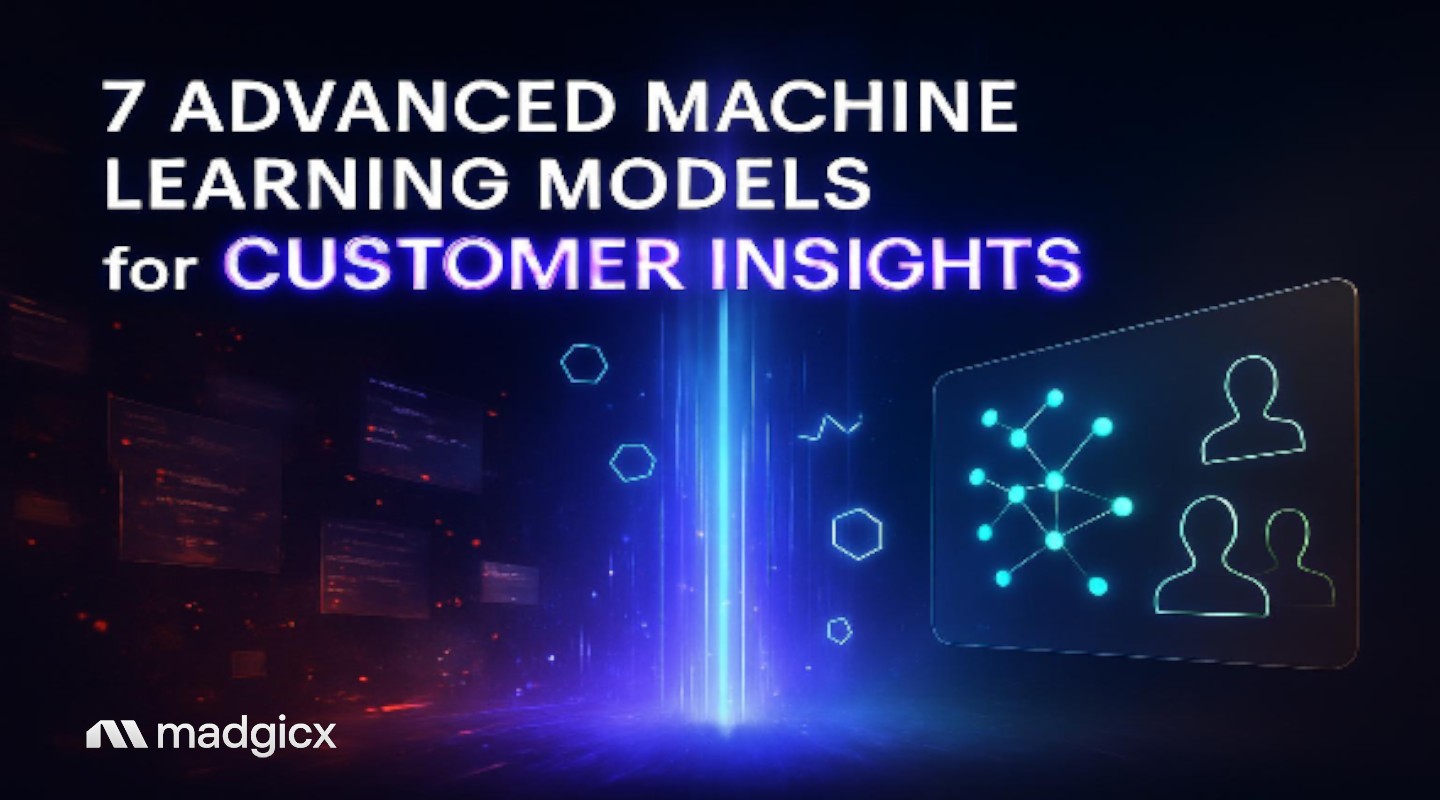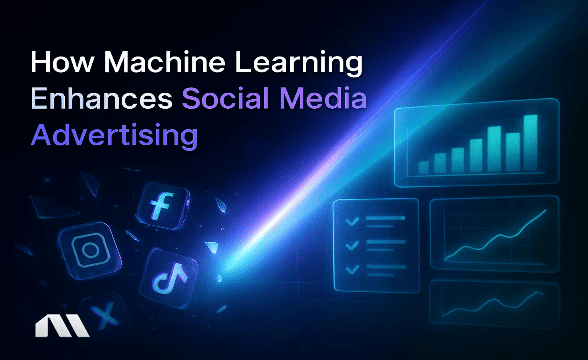Discover how advanced ML models predict customer behavior, reduce churn, and increase revenue. Complete guide with real examples and ROI data.
Picture this: You're scrolling through your customer dashboard on a Monday morning, and instead of seeing confusing spreadsheets, you're looking at crystal-clear predictions. You know exactly which customers are about to churn, which products each segment craves, and how to personalize every touchpoint for maximum impact.
Sound too good to be true? Here's the reality check that might surprise you: 92% accuracy in predicting consumer behavior isn't science fiction anymore—it's what advanced neural networks are delivering right now, compared to just 72% with traditional A/B testing methods.
Yet here's what's frustrating: while 86% of marketers are already using AI for predictive analytics, most are barely scratching the surface. They're sitting on goldmines of customer data but struggling to turn insights into actual revenue growth.
The gap between having data and extracting actionable insights continues to widen, but the marketers who crack this code are seeing game-changing results. We're talking about 15-25% reductions in churn rates, 5-8% revenue increases, and the kind of customer understanding that makes your competitors wonder what you're doing differently.
This guide reveals the 7 most effective machine learning models for customer insights, complete with implementation frameworks, real performance metrics, and step-by-step guidance that doesn't require a PhD in data science.
What You'll Learn
By the end of this guide, you'll have:
- 7 proven ML models that predict customer behavior with 90%+ accuracy
- A step-by-step implementation framework for marketing teams (no coding required)
- Real ROI calculations showing how to measure 15-25% churn reduction and 5-8% revenue increases
- A decision tree for choosing the right model for your specific use case
Let's dive in.
Understanding ML Models for Customer Insights
Let's cut through the technical jargon and focus on what actually matters for your marketing results.
Machine learning for customer insights is the use of AI algorithms that analyze customer data to predict future behavior, preferences, and lifetime value. Unlike traditional analytics that tell you what happened, ML models tell you what's likely to happen next—and more importantly, what you should do about it.
Think of it this way: traditional analytics is like looking in your rearview mirror while driving. Machine learning is like having a GPS that not only shows you where you're going but predicts traffic patterns, suggests the best routes, and adapts in real-time to changing conditions.
The core technologies powering these insights include:
- Predictive Analytics: Algorithms that forecast future customer actions based on historical patterns
- Neural Networks: Complex systems that mimic human brain processing to identify sophisticated behavior patterns
- Clustering Algorithms: Methods that group customers with similar characteristics and behaviors
- Natural Language Processing (NLP): AI that understands and analyzes customer sentiment from text data
Here's what makes this particularly exciting for performance marketers: machine learning models for audience segmentation can now process millions of data points in seconds, identifying patterns that would take human analysts months to discover.
Pro Tip: Start with one model and scale gradually rather than implementing everything at once. The most successful implementations we've seen begin with customer segmentation, then layer on additional models as teams build confidence and expertise.
The 7 Most Effective ML Models for Customer Insights
Model 1: Customer Segmentation with K-Means Clustering
What it does: Groups customers based on behavior patterns, purchase history, and engagement levels to create distinct segments for targeted marketing.
Best for: Personalized marketing campaigns, email segmentation, and ad targeting optimization.
K-means clustering analyzes multiple customer attributes simultaneously—think purchase frequency, average order value, product preferences, and engagement patterns—then automatically groups customers who share similar characteristics. Unlike manual segmentation based on demographics, this approach reveals behavioral patterns you might never have considered.
Expected results: 20-30% improvement in campaign performance when compared to broad targeting approaches.
Implementation approach: Start with 3-5 segments based on your most important business metrics. Common segments include high-value frequent buyers, price-sensitive shoppers, occasional purchasers, and at-risk customers. As you gather more data and refine your approach, you can expand to more granular segments.
The beauty of this model lies in its simplicity and immediate applicability. You can implement basic clustering with existing customer data and see results within weeks, not months.
Model 2: Churn Prediction with Random Forests
What it does: Identifies customers likely to stop purchasing or engaging with your brand based on behavioral signals and engagement patterns.
Best for: Retention campaigns, customer success initiatives, and proactive customer service interventions.
Random forest algorithms excel at churn prediction because they can handle multiple variables simultaneously and identify complex patterns that single-variable analysis might miss. The model looks at factors like declining engagement, reduced purchase frequency, support ticket patterns, and even seasonal behavior changes.
Expected results: 15-25% reduction in churn rates when combined with targeted retention campaigns.
Key metrics to monitor: Declining email open rates, reduced website visits, longer gaps between purchases, decreased average order values, and changes in product category preferences.
Implementation strategy: Begin by defining what "churn" means for your business—is it 90 days without a purchase, 6 months of inactivity, or subscription cancellation? Then train your model on historical data to identify the warning signs that preceded past churn events.
The most successful churn prediction implementations we've seen combine the ML model with automated intervention workflows. When the model flags a high-risk customer, it triggers personalized retention campaigns, special offers, or customer success outreach.
Model 3: Customer Lifetime Value (CLV) Prediction
What it does: Forecasts the total revenue a customer will generate over their entire relationship with your business.
Best for: Budget allocation decisions, acquisition strategy optimization, and customer prioritization.
CLV prediction models analyze purchase patterns, engagement levels, and customer characteristics to estimate future value. This goes far beyond simple calculations based on past purchases—advanced models factor in seasonality, product lifecycle changes, and even external market conditions.
Expected results: 10-15% improvement in marketing ROI through better budget allocation and customer acquisition targeting.
Implementation focus: Start by identifying the characteristics of your highest-value customers. What products do they buy first? How quickly do they make repeat purchases? What engagement patterns predict long-term value? Use these insights to optimize your acquisition campaigns and customer onboarding processes.
For e-commerce businesses, machine learning in e-commerce marketing has proven particularly effective for CLV prediction, especially when combined with product recommendation engines.
Model 4: Personalized Recommendations with Collaborative Filtering
What it does: Suggests products or content based on similar customer preferences and behavior patterns.
Best for: E-commerce platforms, content websites, and cross-selling campaigns.
Collaborative filtering works by finding customers with similar preferences and recommending items that similar customers have purchased or engaged with. It's the technology behind Amazon's "customers who bought this also bought" feature, which reportedly drives 35% of their sales.
Expected results: 35% increase in sales conversion rates and 20-25% improvement in average order value.
Quick win implementation: Start with "customers who bought this also bought" recommendations on product pages and in post-purchase emails. This requires minimal setup but can deliver immediate results.
Advanced implementation: Develop real-time personalization that adapts recommendations based on current browsing behavior, seasonal trends, and inventory levels. The most sophisticated systems combine collaborative filtering with content-based filtering to handle new products and customers with limited purchase history.
Model 5: Sentiment Analysis with Natural Language Processing
What it does: Analyzes customer emotions and opinions from text data including reviews, social media posts, support tickets, and survey responses.
Best for: Brand monitoring, customer service optimization, and product development insights.
NLP sentiment analysis goes beyond simple positive/negative classifications. Advanced models can identify specific emotions (frustration, excitement, disappointment), detect sarcasm, and even predict customer satisfaction scores from text interactions.
Expected results: 15-20% improvement in customer satisfaction scores and 25% reduction in negative review escalations.
Data sources to analyze: Product reviews, social media mentions, customer service chat logs, email responses, and survey feedback. The key is aggregating sentiment across multiple touchpoints to get a complete picture of customer experience.
Implementation approach: Start with review analysis to identify product issues and improvement opportunities. Then expand to social media monitoring and customer service optimization. The insights from sentiment analysis can inform everything from product development to marketing messaging.
Model 6: Demand Forecasting with Time Series Models
What it does: Predicts future product demand based on historical sales data, seasonal patterns, and external factors.
Best for: Inventory optimization, campaign planning, and budget allocation.
Time series forecasting models analyze patterns in historical data to predict future demand. Advanced models incorporate external factors like weather, economic indicators, competitor actions, and marketing campaign effects to improve accuracy.
Expected results: 40% reduction in stockouts and 15-20% improvement in inventory turnover rates.
Implementation strategy: Start with your top 20% of products by revenue. These typically have enough historical data for accurate forecasting and represent the biggest impact on your business. As you refine your models, expand to additional products and incorporate more variables.
Marketing applications: Use demand forecasting to time promotional campaigns, allocate advertising budgets across products, and optimize seasonal marketing strategies. When you know a product will be in high demand, you can increase advertising spend and prepare inventory accordingly.
Model 7: Neural Networks for Complex Pattern Recognition
What it does: Identifies sophisticated behavior patterns and relationships that simpler models might miss.
Best for: Advanced personalization, complex cross-selling strategies, and multi-channel customer journey optimization.
Neural networks excel at finding non-linear relationships and complex patterns in large datasets. They can identify subtle behavioral signals that predict customer actions, optimize multi-step customer journeys, and personalize experiences across multiple touchpoints simultaneously.
Expected results: 92% prediction accuracy versus 72% with traditional methods, plus 25-30% improvement in conversion rates for complex customer journeys.
Consideration: Neural networks require larger datasets (typically 10,000+ customer records) and more technical expertise than simpler models. However, platforms like Madgicx make advanced neural network capabilities accessible without requiring in-house data science teams.
Best applications: Multi-channel attribution, complex product bundling recommendations, and predicting customer lifetime journeys across multiple touchpoints. These models shine when you need to understand how customers behave across email, social media, website, and offline interactions.
Real-World Success Stories
Major US Airline Transformation
A major US airline was hemorrhaging valuable customers and couldn't figure out why. Traditional analytics showed them who was leaving but not who was about to leave or what they could do about it.
The Challenge: High customer churn among their most valuable frequent flyers, with traditional retention efforts showing minimal impact.
The Solution: They implemented ML-powered churn prediction combined with personalized intervention campaigns. The system analyzed booking patterns, service interactions, and even social media sentiment to identify at-risk customers.
The Results: They achieved a 210% improvement in targeting accuracy, 59% reduction in churn among high-value customers, and an 800% increase in customer satisfaction scores for intervention campaigns.
European Telecom Success
A European telecommunications company was struggling with customer satisfaction scores that lagged behind competitors despite significant investment in customer service.
The Challenge: Poor customer satisfaction scores and inability to proactively address customer issues before they escalated.
The Solution: They deployed an AI-powered "next best experience" platform that combined sentiment analysis, churn prediction, and personalized recommendation engines to optimize every customer interaction.
The Results: Within 18 months, they achieved market leader NPS levels and reduced customer service costs by 30% while improving satisfaction scores.
E-commerce Success Stories
Amazon's Personalization Engine: Their collaborative filtering and neural network systems reportedly drive 35% of total sales through personalized recommendations.
Walmart's Demand Forecasting: Advanced machine learning algorithms helped them achieve a reduction in stockouts while optimizing inventory across thousands of locations.
Sephora's Virtual Artist: Their AI-powered personalization and recommendation system significantly boosted customer engagement and conversion rates by helping customers find products that match their preferences and skin tones.
Madgicx Customer Success
One of our mid-market e-commerce customers implemented our Creative Insights AI to better understand which ad creatives resonated with different customer segments. By analyzing customer behavior patterns and creative performance data, they achieved:
- 45% improvement in ad creative performance
- 30% reduction in cost per acquisition
- 25% increase in return on ad spend
The key was combining machine learning models for ad targeting with creative optimization to deliver the right message to the right customer at the right time.
Implementation Framework: Your 3-Phase Roadmap
Phase 1: Foundation Building (Month 1)
Week 1-2: Data Audit and Quality Assessment
Start by auditing your existing customer data. You'll need clean, consistent data across multiple touchpoints—purchase history, website behavior, email engagement, and customer service interactions. Don't worry if your data isn't perfect; most businesses start with imperfect data and improve it over time.
Week 3: Define Clear Business Objectives
Choose one specific business challenge to address first. Are you losing too many customers? Struggling with inventory management? Want to improve personalization? Pick the area with the biggest potential impact and clearest success metrics.
Week 4: Choose Your Pilot Model
Based on your primary challenge and data availability, select one model for your pilot project. Customer segmentation is often the best starting point because it requires less historical data and delivers immediate insights.
Success Metrics to Establish: Define how you'll measure success before you begin. This might be churn rate reduction, conversion rate improvement, or revenue per customer increase.
Phase 2: Pilot Project Execution (Months 2-3)
Month 2: Implementation and Testing
Implement your chosen model with a subset of your customer data. Start small—even 1,000-5,000 customer records can provide valuable insights and help you refine your approach.
Focus on data quality over quantity. It's better to have 1,000 high-quality customer records than 10,000 incomplete ones.
Month 3: Refinement and Initial Results
Test your model's predictions against real customer behavior. Are the segments making sense? Are churn predictions accurate? Use these insights to refine your model and improve accuracy.
Documentation: Keep detailed records of what works and what doesn't. This knowledge will be invaluable as you scale to additional models.
Phase 3: Scale and Optimize (Months 4-6)
Month 4-5: Expand Model Coverage
Add additional models based on your pilot project learnings. If customer segmentation worked well, consider adding churn prediction or CLV forecasting.
Month 6: Integration and Automation
Integrate your ML insights with existing marketing systems. This might mean connecting churn predictions to your email marketing platform or feeding segmentation data into your advertising campaigns.
Team Training: Ensure your marketing team understands how to interpret and act on ML insights. The best models in the world won't help if your team doesn't know how to use them.
Quick Implementation Tips
- Start with high-quality, clean data: Spend time on data preparation—it's the foundation of everything else
- Focus on business impact over technical sophistication: Choose models that solve real business problems, not just impressive technical challenges
- Build cross-functional teams: Include marketing, data, and customer service perspectives in your implementation
- Plan for ongoing maintenance: ML models need regular updates and refinement to maintain accuracy
For businesses looking to accelerate this process, platforms like Madgicx handle much of the technical complexity while providing access to advanced machine learning models for campaign optimization. The platform applies advanced Meta audience segmentation, creative insights, and predictive budgeting automatically, helping brands boost performance and scale faster without the technical complexity.
ROI Calculation and Budget Planning
Investment Breakdown by Business Size
Small Business (Under $50K Monthly Ad Spend)
- Initial investment: $2,000-$5,000
- Includes: Basic segmentation and churn prediction models
- Timeline: 2-3 months to implementation
- Expected ROI: 200-300% within first year
Mid-Market ($50K-$500K Monthly Ad Spend)
- Initial investment: $10,000-$25,000
- Includes: Multiple ML models, integration support, team training
- Timeline: 3-4 months to full implementation
- Expected ROI: 300-500% within first year
Enterprise ($500K+ Monthly Ad Spend)
- Initial investment: $25,000-$100,000+
- Includes: Custom model development, advanced analytics, dedicated support
- Timeline: 4-6 months to full implementation
- Expected ROI: 400-600% within first year
Expected Returns and Impact
Churn Reduction Benefits
A 15-25% reduction in churn rate translates directly to retained revenue. For a business with $1M annual revenue and 20% churn rate, a 20% churn reduction saves $40,000 annually.
Revenue Increase from Personalization
The 5-8% revenue increase from improved personalization compounds over time. For that same $1M business, a 6% increase equals $60,000 additional annual revenue.
Cost Reduction in Customer Acquisition
Better targeting and segmentation typically reduce customer acquisition costs by 20-30%. If you're spending $100,000 annually on customer acquisition, that's $20,000-$30,000 in savings.
ROI Timeline Expectations
Pilot Results: 1-3 months after implementation
- Initial insights and model validation
- Early indicators of performance improvement
- Refined understanding of data quality and model accuracy
Full Implementation Impact: 3-6 months
- Measurable improvements in key metrics
- Integrated workflows and automated processes
- Team adoption and optimization
Positive ROI Achievement: 6-12 months
- Cumulative benefits exceed initial investment
- Sustained performance improvements
- Foundation for additional model expansion
ROI Calculation Framework:
Annual ROI = (Revenue Increase + Cost Savings - Implementation Cost) / Implementation Cost × 100
Example: ($60,000 + $25,000 - $15,000) / $15,000 × 100 = 467% RO
Common Challenges and Proven Solutions
Challenge 1: Data Quality and Consistency Issues
The Problem: Inconsistent data formats, missing information, and siloed data sources that prevent effective model training.
The Solution: Start with a comprehensive data audit and cleaning process. Focus on your most reliable data sources first, then gradually incorporate additional data as you improve collection and standardization processes.
Pro Tip: Don't wait for perfect data. Start with what you have and improve data quality iteratively. Many successful implementations begin with 70-80% data quality and improve over time.
Challenge 2: Technical Complexity and Resource Constraints
The Problem: Limited technical expertise and resources to implement and maintain sophisticated ML models.
The Solution: Use platforms like Madgicx that handle the technical complexity while providing access to advanced ML capabilities. This allows marketing teams to focus on strategy and implementation rather than technical details.
Alternative Approach: Partner with specialists for custom solutions, but ensure knowledge transfer so your team can maintain and optimize models over time.
Challenge 3: Team Adoption and Change Management
The Problem: Marketing teams struggling to interpret ML insights and integrate them into existing workflows.
The Solution: Focus on business outcomes rather than technical details. Provide clear interpretation guidelines and start with simple, actionable insights before moving to more complex analyses.
Training Strategy: Begin with hands-on workshops using real data from your business. Show team members how ML insights directly impact their daily decisions and campaign performance.
Challenge 4: Privacy and Compliance Concerns
The Problem: Ensuring GDPR, CCPA, and other privacy regulation compliance while maximizing data utility.
The Solution: Build privacy compliance into your ML strategy from the beginning. Use anonymized data where possible, implement proper consent management, and ensure data processing transparency.
Best Practice: Work with legal and compliance teams to establish clear guidelines for data usage and model implementation. This prevents issues down the road and builds stakeholder confidence.
For businesses looking to navigate these challenges more effectively, machine learning in marketing automation provides additional strategies for successful implementation.
Frequently Asked Questions
How accurate are ML predictions for customer behavior?
Advanced neural networks achieve 92% accuracy in predicting consumer behavior, significantly outperforming traditional A/B testing at 72%. However, accuracy varies by model type, data quality, and business complexity. Simpler models like customer segmentation might achieve 80-85% accuracy, while sophisticated neural networks can reach 90%+ with sufficient data.
What's the minimum data requirement for ML models?
Most models need at least 1,000 customer records for basic segmentation, though 10,000+ records provide significantly better accuracy. Time series models for demand forecasting require 12-24 months of historical data. Churn prediction works best with at least 6 months of customer behavior data, including both churned and retained customers.
How long does implementation typically take?
Pilot projects take 1-3 months, full deployment 3-6 months for most businesses. Using platforms like Madgicx can reduce implementation time by 50-70% compared to building custom solutions. The timeline depends on data quality, model complexity, and integration requirements.
Can small businesses benefit from ML customer insights?
Absolutely. Even businesses with $10,000 monthly ad spend can see 15-20% improvements using automated ML platforms that don't require technical expertise. The key is starting with simple models like customer segmentation and scaling up as you see results and build confidence.
How do I choose between different ML models?
Start with your biggest pain point: churn prediction for retention issues, segmentation for personalization needs, or CLV prediction for budget allocation challenges. Consider your data availability and technical resources. Customer segmentation is often the best starting point because it requires less historical data and provides immediate actionable insights.
What's the difference between AI and machine learning for marketing?
Machine learning is a subset of AI focused on algorithms that learn from data to make predictions. For marketing, ML specifically refers to predictive models for customer behavior, while AI encompasses broader applications like chatbots, content generation, and automated decision-making. Most customer insight applications use ML techniques.
How do I measure the success of ML implementations?
Focus on business metrics rather than technical accuracy. Key indicators include churn rate reduction (15-25% is excellent), revenue per customer increase (5-8% is strong), conversion rate improvement (20-30% for targeted campaigns), and customer acquisition cost reduction (20-30% through better targeting).
Transform Your Customer Insights Today
The data is clear: businesses using advanced machine learning for customer insights are pulling ahead of their competition. With 92% prediction accuracy now achievable, the question isn't whether to implement ML models—it's how quickly you can get started.
Here's what we've covered:
- The 7 Essential Models: From customer segmentation with K-means clustering to advanced neural networks for pattern recognition, each model serves specific business needs and delivers measurable results.
- Proven Implementation Framework: The 3-phase approach ensures successful deployment, starting with foundation building, moving through pilot projects, and scaling to full implementation.
- Real ROI Expectations: 15-25% churn reduction, 5-8% revenue increases, and 20-30% improvements in campaign performance are not just possible—they're typical results for well-implemented ML strategies.
- Clear Success Metrics: Quality data, defined business objectives, and proper team training form the foundation of every successful implementation.
The most successful businesses start simple and scale systematically. Begin with customer segmentation using your existing data—this provides immediate insights while building the foundation for more advanced models. As you see results and build confidence, layer on churn prediction, CLV forecasting, and personalization engines.
For businesses looking to accelerate this process, machine learning for conversion rate optimization combined with platforms like Madgicx can deliver enterprise-level ML capabilities without the complexity of building custom solutions.
The competitive advantage goes to businesses that act now. Your customer data is already generating insights—the question is whether you'll be the one extracting them or watching competitors pull ahead.
Transform your customer data into predictive insights that drive real results. Madgicx's AI Marketer uses advanced machine learning to automatically optimize your Meta campaigns based on customer behavior patterns, while our Creative Insights AI helps you understand which content resonates with different customer segments.
Digital copywriter with a passion for sculpting words that resonate in a digital age.







.avif)







